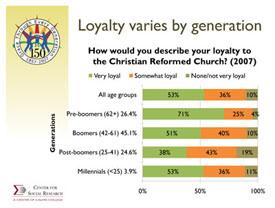Survey Tracks Changes in CRC

A recent membership survey by the Christian Reformed Church in North America revealed some declines in denominational loyalty and devotional practices, especially among younger members, while overall church attendance has remained steady and the number of college-educated church members is on the rise.
The survey is the most recent in a series conducted every five years since 1987 by researchers at the Center for Social Research at Calvin College in Grand Rapids, Mich. They randomly selected 120 churches to participate in the study by asking them to have their members respond to the online survey.
“There are trends in demography and religious practice that are not very encouraging here,” says Neal Carlson, assistant director of the CSR. At the same time, though, researchers found encouraging responses that can help church leaders as they work to identify, establish and support healthy churches.
For the first time, says Carlson, the survey asked questions of individual church members about the factors – the good and bad, the healthy the not so healthy -- that make up their own congregation. As a result, the survey found, for instance, strong support for more updated modes of spiritual learning as well as an emphasis on the need to bolster one’s personal spiritual health.
CSR staff and students designed and fielded the survey in collaboration with Rodger Rice, former director of CSR, who is working for the Barnabas Foundation. Rice has done several of these surveys starting in 1987. The design team also included representatives of several denominational agencies, and drew heavily on the CRC’s Healthy Congregation Initiative for survey questions.
In a recent presentation of the preliminary findings to the CRC Board of Trustees, researchers said the study, one of the largest of its kind in many years, found that the constituency of the CRC continues to age, more households have fewer or no children, a declining proportion of children are attending Christian schools, evening attendance at services is dropping, and real household income rose slightly. These findings reflect trends that have been observed over the last 15 to 20 years.
While the big picture may look disturbing, says Carlson, there are signs that the church understands the demographic and spiritual challenges and has started to move “its response to deal with the old patterns. The trends confirm that we need to act and the (CRC’s) focus on Healthy Congregations shows that we are acting,” says Carlson. “The church sees that there are opportunities and is starting to take advantage of them.”
The survey is called the “150th Anniversary Survey,” since it was commissioned in the CRC’s anniversary year of 2007. It is the fifth in a series of surveys Rice has conducted every five years since 1987 and the first to be online. In prior years, the surveys were sent out in the mail.
Given that the survey is an online tool, it allows for a relatively inexpensive replication of another survey in the near future if the church so desires. “We have the infrastructure in place to do more. We could involve more churches in future surveys and do so more often than every five years,” says Carlson.
The survey took place online between November 4 and December 21, 2007. Of the 120 churches asked to participate, 67 participated in some way. The churches themselves recruited the respondents, including non-members, and asked them to participate. Surveys were offered in the Korean and Spanish languages.
“Some churches really went into this in-depth, while others weren’t so involved,” says Carlson. “Churches that recruited at least 30 respondents received a detailed report just for their congregation comparing their congregational health item by item to national and denominational averages.”
Since the survey was able to ask questions of people about the congregations which they attend, researchers have an idea of what churchgoers see as the elements making up a healthy congregation.
Although the survey results are not finalized, researchers came up with five keys to what respondents say make for healthier congregations. These are congregations that emphasize spiritual development, stewardship education, leadership training, intentionally work at faith formation, and stay close to members so they can understand their spiritual and other needs.
Some of the anonymous comments contained in the survey reflect what people see as adding to the health of their congregation.
Michael Bruinooge, who is helping in the effort to sustain healthy congregations, said the survey included questions that his office suggested. For example, respondents were asked how true certain statements would be for their congregation, such as:
“When people join our church, there is a clear expectation that they will engage in a lifelong process of following Jesus.”
“Our church encourages the spiritual disciplines such as prayer, Bible reading, silence and solitude.”
“Our church provides a variety of small groups to foster community and accountability.”
Bruinooge said that the results of the survey will help in formation of programs and initiatives to help foster and support healthy congregations. Carlson said a report on the survey will likely be finalized and presented to the church late this summer.


